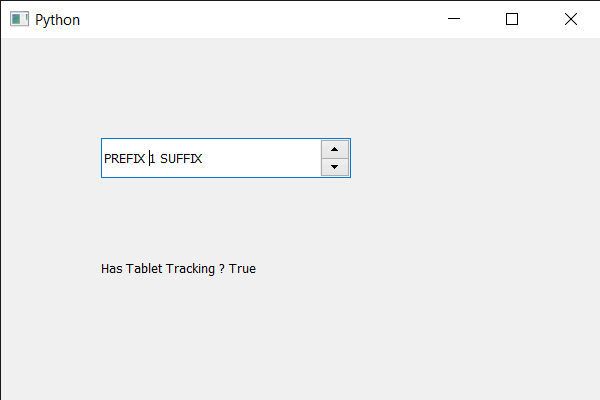En este artículo, veremos cómo podemos configurar el seguimiento de tabletas en el cuadro de número. Por defecto, el seguimiento de la tableta está desactivado, aunque podemos cambiar esto en cualquier momento. Si el seguimiento de la tableta está desactivado, los eventos de movimiento de la tableta solo ocurren si el lápiz está en contacto con la tableta, o si se presiona al menos un botón del lápiz mientras se mueve el lápiz. Si el seguimiento de la tableta está activado, los eventos de movimiento de la tableta ocurren incluso cuando el lápiz óptico se encuentra cerca de la tableta, sin presionar ningún botón.
Para hacer esto, usamos setTabletTrackingel método con el objeto de cuadro de número.
Sintaxis: spin_box.setTabletTracking(Verdadero)
Argumento: toma bool como argumento
Retorno : Devuelve Ninguno
A continuación se muestra la implementación.
# importing libraries
from PyQt5.QtWidgets import *
from PyQt5 import QtCore, QtGui
from PyQt5.QtGui import *
from PyQt5.QtCore import *
import sys
class Window(QMainWindow):
def __init__(self):
super().__init__()
# setting title
self.setWindowTitle("Python ")
# setting geometry
self.setGeometry(100, 100, 600, 400)
# calling method
self.UiComponents()
# showing all the widgets
self.show()
# method for widgets
def UiComponents(self):
# creating spin box
self.spin = QSpinBox(self)
# setting tablet tracking to the spin box
self.spin.setTabletTracking(True)
# setting geometry to spin box
self.spin.setGeometry(100, 100, 250, 40)
# setting range to the spin box
self.spin.setRange(1, 999999)
# setting prefix to spin
self.spin.setPrefix("PREFIX ")
# setting suffix to spin
self.spin.setSuffix(" SUFFIX")
# creating a label
label = QLabel(self)
# making the label multi line
label.setWordWrap(True)
# setting geometry to the label
label.setGeometry(100, 200, 200, 60)
# checking if spin box has tablet tracking
check = self.spin.hasTabletTracking()
# setting text to the label
label.setText("Has Tablet Tracking ? " + str(check))
# create pyqt5 app
App = QApplication(sys.argv)
# create the instance of our Window
window = Window()
# start the app
sys.exit(App.exec())
Producción :
Publicación traducida automáticamente
Artículo escrito por rakshitarora y traducido por Barcelona Geeks. The original can be accessed here. Licence: CCBY-SA